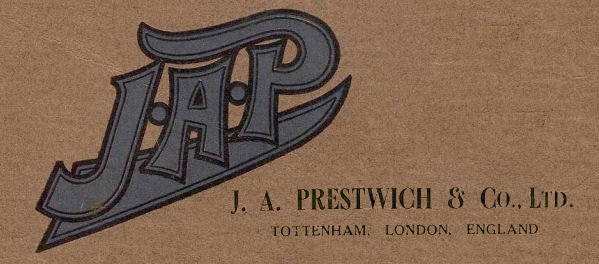


The newly-designed 2¾ h.p. J.A.P. engine

Years of experience are behind the production of J.A.P. engines. Here is shown the new 5 h.p. model.
Improved Cooling, Timing Gear and Finish.
CONSIDERABLE improvements have been made in the construction and design of the latest pattern J.A.P. engines, and on this occasion of our last visit to Messrs. J. A. Prestwich and Co.'s now extensive factory we were struck by the excellence of finish and workmanship. The die-cast aluminium crank case and the polished timing gear and chain case look particularly attractive, and give the engine an extremely handsome appearance. Other external improvements are also evident. It can be seen from the illustrations that the cylinder fins are numerous and thin, while their shape has been slightly modified. The apex oil union has been discarded, and an oil lead to the front cylinder is now permanently built in. These features are common to all of the twin-cylinder models. The chief difference, however, in the 5 h.p. twin-cylinder is the simplification of the timing gear, which now follows the design of the 8 h.p., there being only two timing wheels, a small pinion and the larger one carrying two cams operating all four valves. The position of the compression taps has also been altered, and instead of being in the centre of the cylinder, these are now at the side opposite to the valve cap. A straight induction pipe now joins the two unions, whereas formerly this was arranged in the shape of an inverted V.
Racing models are fitted with long "fir cone" pattern aluminium exhaust valve caps, which, we are assured, dissipate the heat very rapidly.
Engines for All.
The 8 h.p. water-cooled engine for cycle cars has also undergone considerable improvement, and is now provided with larger water jackets. It follows the lines of the air-cooled pattern in most other respects.
New pistons are fitted to all types, and these are provided with two thin rings at the top, and one scraper ring at the bottom, while the gudgeon pins are a driving fit, and have brass caps at their extremities.
The popular little 2¾ h.p. has also been slightly altered in design. The cylinder has many more radiating fins, and those on the top of the cylinder run longitudinally, thereby greatly aiding the cooling. One of these we saw fitted with three overhead valves (two exhaust and one inlet), and a similar side-by-side valve engine with an aluminium piston, roller big end and ball bearing crankshaft, with which Mr. Vivian Prestwich intends to attack the lightweight records.
There is also a six-valve twin-cylinder racing engine of 500 c.c.
Extreme care has been exercised in the manufacture of these engines and their wonderful finish is noteworthy. There seems little doubt that the popularity of the J.A.P. during 1921 will be enormously extended, all the brains in the factory being concentrated on obtaining the highest possible efficiency in every respect.
The Motor Cycle November 18th, 1920. Page 596